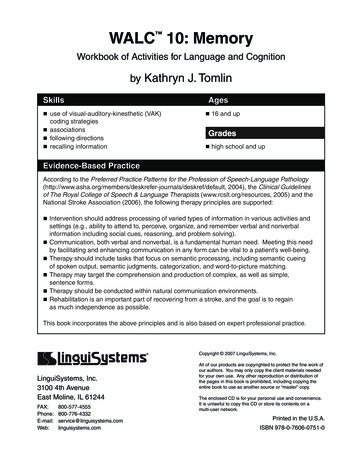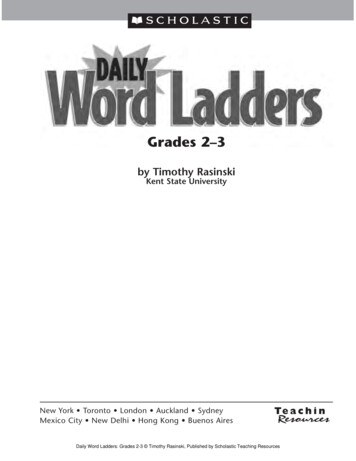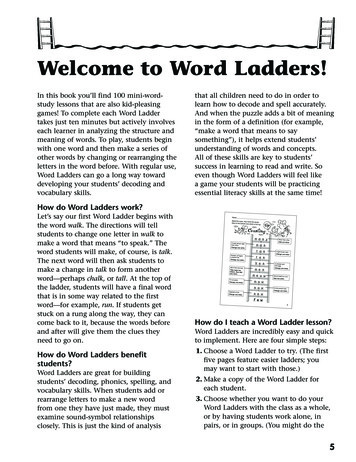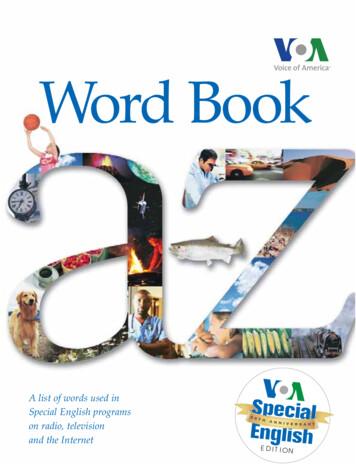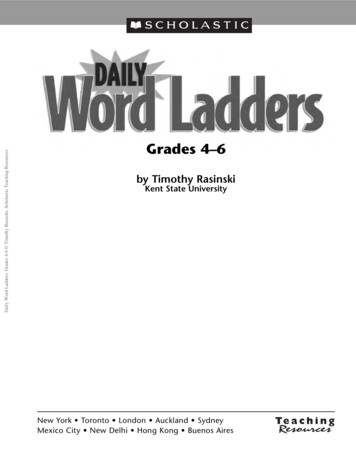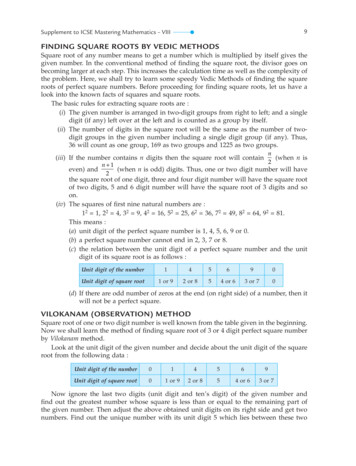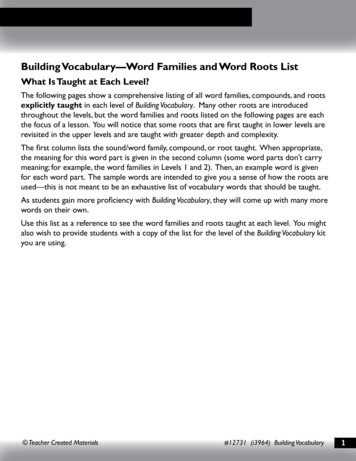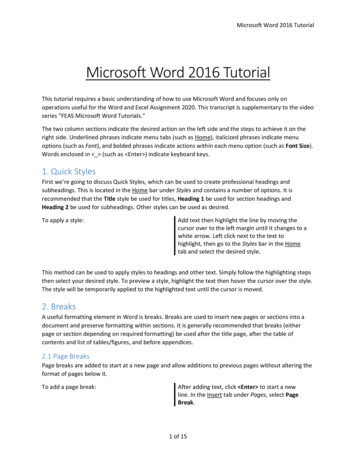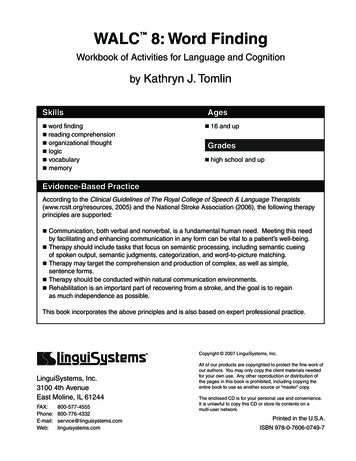
Transcription
WALC 8: Word FindingWorkbook of Activities for Language and Cognitionby Kathryn J. TomlinSkillsword findingreading comprehensionorganizational thoughtlogicvocabularymemoryAges16 and upGradeshigh school and upEvidence-Based PracticeAccording to the Clinical Guidelines of The Royal College of Speech & Language Therapists(www.rcslt.org/resources, 2005) and the National Stroke Association (2006), the following therapyprinciples are supported:Communication, both verbal and nonverbal, is a fundamental human need. Meeting this needby facilitating and enhancing communication in any form can be vital to a patient’s well-being.Therapy should include tasks that focus on semantic processing, including semantic cueingof spoken output, semantic judgments, categorization, and word-to-picture matching.Therapy may target the comprehension and production of complex, as well as simple,sentence forms.Therapy should be conducted within natural communication environments.Rehabilitation is an important part of recovering from a stroke, and the goal is to regainas much independence as possible.This book incorporates the above principles and is also based on expert professional practice.Copyright 2007 LinguiSystems, Inc.LinguiSystems, Inc.3100 4th AvenueEast Moline, IL service@linguisystems.comlinguisystems.comAll of our products are copyrighted to protect the fine work ofour authors. You may only copy the client materials neededfor your own use. Any other reproduction or distribution ofthe pages in this book is prohibited, including copying theentire book to use as another source or “master” copy.The enclosed CD is for your personal use and convenience.It is unlawful to copy this CD or store its contents on amulti-user network.Printed in the U.S.A.ISBN 978-0-7606-0749-7
About the AuthorKathryn J. Tomlin, M.S., CCC-SLP, has been a speech-languagepathologist in hospitals, rehabilitation centers, and long-termcare facilities for over 25 years. Her materials, developed whileworking with clients, have evolved over the years. She hasauthored many materials with LinguiSystems over the last 20years. Some of her works include:Kathy and her therapy dog, ZanmiThe Source for Apraxia TherapyWALC (Workbook of Activities for Language and Cognition) Series— WALC 1: Aphasia Rehab (English and Spanish versions) WALC 2: Cognitive Rehab (English and Spanish versions) WALC 8: Word Finding WALC 10: Memory WALC 11: Language for Home ActivitiesZanmi, Kathy’s Samoyed, goes to work with her to encourageclients. Her clients enjoy feeding and spending time with Zanmi,and Zanmi enjoys their company. Everybody wins!DedicationThis book is dedicated to Ann Hollenbach, in appreciation for her years of professionalsupport, personal friendship, and thousands of laughs.Edited by Lauri WhiskeymanCover Design by Jason PlattIllustrations by Margaret WarnerPage Layout by Christine Buysse & Lisa Parker
Table of ContentsIntroduction . . . . . . . . . . . . . . . . . . . . . . . . . . . . . . . . . . . . . . . . . . . . . . . . . . . . . . . . . . . . . 5Answering Questions. . . . . . . . . . . . . . . . . . . . . . . . . . . . . . . . . . . . . . . . . . . . . . . . . . . . . . 8General Information—Answers Provided . . . . . . . . . . . . . . . . . . . . . . . . . . . . . . . . . . . . . 9Sports—Answers Provided . . . . . . . . . . . . . . . . . . . . . . . . . . . . . . . . . . . . . . . . . . . . . . 11Food—Answers Provided . . . . . . . . . . . . . . . . . . . . . . . . . . . . . . . . . . . . . . . . . . . . . . . . 12People and Places—Answers Provided . . . . . . . . . . . . . . . . . . . . . . . . . . . . . . . . . . . . . 13Animals—Answers Provided . . . . . . . . . . . . . . . . . . . . . . . . . . . . . . . . . . . . . . . . . . . . . 14Cars—Answers Provided . . . . . . . . . . . . . . . . . . . . . . . . . . . . . . . . . . . . . . . . . . . . . . . . 16General Information . . . . . . . . . . . . . . . . . . . . . . . . . . . . . . . . . . . . . . . . . . . . . . . . . . . . 17General Information—People and Characters . . . . . . . . . . . . . . . . . . . . . . . . . . . . . . . . 23General Information—Animals . . . . . . . . . . . . . . . . . . . . . . . . . . . . . . . . . . . . . . . . . . . . 24General Information—Numbers . . . . . . . . . . . . . . . . . . . . . . . . . . . . . . . . . . . . . . . . . . . 25General Information—Brand Names . . . . . . . . . . . . . . . . . . . . . . . . . . . . . . . . . . . . . . . 26Building Categorization Skills. . . . . . . . . . . . . . . . . . . . . . . . . . . . . . . . . . . . . . . . . . . . . .Category Members . . . . . . . . . . . . . . . . . . . . . . . . . . . . . . . . . . . . . . . . . . . . . . . . . . . . .Naming Category Members . . . . . . . . . . . . . . . . . . . . . . . . . . . . . . . . . . . . . . . . . . . . . .Adding to a Category . . . . . . . . . . . . . . . . . . . . . . . . . . . . . . . . . . . . . . . . . . . . . . . . . . .27283336Using Word Relationships . . . . . . . . . . . . . . . . . . . . . . . . . . . . . . . . . . . . . . . . . . . . . . . . .Providing Opposites . . . . . . . . . . . . . . . . . . . . . . . . . . . . . . . . . . . . . . . . . . . . . . . . . . . .Unscrambling Opposite Pairs . . . . . . . . . . . . . . . . . . . . . . . . . . . . . . . . . . . . . . . . . . . . .Unscrambling Synonym Pairs . . . . . . . . . . . . . . . . . . . . . . . . . . . . . . . . . . . . . . . . . . . .Listing Opposites . . . . . . . . . . . . . . . . . . . . . . . . . . . . . . . . . . . . . . . . . . . . . . . . . . . . . .Listing Synonyms . . . . . . . . . . . . . . . . . . . . . . . . . . . . . . . . . . . . . . . . . . . . . . . . . . . . . .Listing Homonyms . . . . . . . . . . . . . . . . . . . . . . . . . . . . . . . . . . . . . . . . . . . . . . . . . . . . .Providing Three Synonyms . . . . . . . . . . . . . . . . . . . . . . . . . . . . . . . . . . . . . . . . . . . . . .Providing Synonyms and Opposites . . . . . . . . . . . . . . . . . . . . . . . . . . . . . . . . . . . . . . . .394043454748495052Using Word Strategies . . . . . . . . . . . . . . . . . . . . . . . . . . . . . . . . . . . . . . . . . . . . . . . . . . . .Matching Definitions . . . . . . . . . . . . . . . . . . . . . . . . . . . . . . . . . . . . . . . . . . . . . . . . . . . .Rhyming Words . . . . . . . . . . . . . . . . . . . . . . . . . . . . . . . . . . . . . . . . . . . . . . . . . . . . . . .Naming Words by Letter . . . . . . . . . . . . . . . . . . . . . . . . . . . . . . . . . . . . . . . . . . . . . . . . .Choosing Two Definitions . . . . . . . . . . . . . . . . . . . . . . . . . . . . . . . . . . . . . . . . . . . . . . . .Word Chaining . . . . . . . . . . . . . . . . . . . . . . . . . . . . . . . . . . . . . . . . . . . . . . . . . . . . . . . .Completing Words. . . . . . . . . . . . . . . . . . . . . . . . . . . . . . . . . . . . . . . . . . . . . . . . . . . . . .54555962687175WALC 8: Word Finding3Copyright 2007 LinguiSystems, Inc.
Table of Contents, continuedDeducing Compound Words . . . . . . . . . . . . . . . . . . . . . . . . . . . . . . . . . . . . . . . . . . . . . 81Naming from Definition . . . . . . . . . . . . . . . . . . . . . . . . . . . . . . . . . . . . . . . . . . . . . . . . . . 85Naming from Given Word Ending . . . . . . . . . . . . . . . . . . . . . . . . . . . . . . . . . . . . . . . . . . 90Building Words . . . . . . . . . . . . . . . . . . . . . . . . . . . . . . . . . . . . . . . . . . . . . . . . . . . . . . . . 98Completing a Word Puzzle . . . . . . . . . . . . . . . . . . . . . . . . . . . . . . . . . . . . . . . . . . . . . . 101Word Finding Through Letter Exclusion . . . . . . . . . . . . . . . . . . . . . . . . . . . . . . . . . . . . 104Unscrambling Letters Plus One . . . . . . . . . . . . . . . . . . . . . . . . . . . . . . . . . . . . . . . . . . 107Rearranging Words . . . . . . . . . . . . . . . . . . . . . . . . . . . . . . . . . . . . . . . . . . . . . . . . . . . . 109Adding Vowels to Form Words . . . . . . . . . . . . . . . . . . . . . . . . . . . . . . . . . . . . . . . . . . . 112Carrying Two Letters to Form Words . . . . . . . . . . . . . . . . . . . . . . . . . . . . . . . . . . . . . . 115Carrying One Letter to Form Words . . . . . . . . . . . . . . . . . . . . . . . . . . . . . . . . . . . . . . . 117Changing Words by One Letter . . . . . . . . . . . . . . . . . . . . . . . . . . . . . . . . . . . . . . . . . . 121Providing Associated Words . . . . . . . . . . . . . . . . . . . . . . . . . . . . . . . . . . . . . . . . . . . . 125Extracting Words from Longer Words . . . . . . . . . . . . . . . . . . . . . . . . . . . . . . . . . . . . . . 129Rhyming Word Pairs . . . . . . . . . . . . . . . . . . . . . . . . . . . . . . . . . . . . . . . . . . . . . . . . . . . 133Matching Compound Words . . . . . . . . . . . . . . . . . . . . . . . . . . . . . . . . . . . . . . . . . . . . . 135Word Building . . . . . . . . . . . . . . . . . . . . . . . . . . . . . . . . . . . . . . . . . . . . . . . . . . . . . . . . 138Matching Syllables to Form Words . . . . . . . . . . . . . . . . . . . . . . . . . . . . . . . . . . . . . . . . 142Rearranging Syllables to Form Words . . . . . . . . . . . . . . . . . . . . . . . . . . . . . . . . . . . . . 146Expanding on Root Word . . . . . . . . . . . . . . . . . . . . . . . . . . . . . . . . . . . . . . . . . . . . . . . 149Completing Words—Beginning . . . . . . . . . . . . . . . . . . . . . . . . . . . . . . . . . . . . . . . . . . 154Completing Words—End. . . . . . . . . . . . . . . . . . . . . . . . . . . . . . . . . . . . . . . . . . . . . . . . 156Completing Words—Middle . . . . . . . . . . . . . . . . . . . . . . . . . . . . . . . . . . . . . . . . . . . . . 158Completing Words—Same Root . . . . . . . . . . . . . . . . . . . . . . . . . . . . . . . . . . . . . . . . . . 160Naming and Selecting Pictures. . . . . . . . . . . . . . . . . . . . . . . . . . . . . . . . . . . . . . . . . . . .Naming Pictures . . . . . . . . . . . . . . . . . . . . . . . . . . . . . . . . . . . . . . . . . . . . . . . . . . . . . .Finding Pictures—Target Letter S . . . . . . . . . . . . . . . . . . . . . . . . . . . . . . . . . . . . . . . .Finding Pictures—Target Letter M . . . . . . . . . . . . . . . . . . . . . . . . . . . . . . . . . . . . . . . .Finding Pictures—Target Letter T . . . . . . . . . . . . . . . . . . . . . . . . . . . . . . . . . . . . . . . .Finding Pictures—Target Letter F . . . . . . . . . . . . . . . . . . . . . . . . . . . . . . . . . . . . . . . .Finding Pictures—Target Letter B . . . . . . . . . . . . . . . . . . . . . . . . . . . . . . . . . . . . . . . .162163173174175176177Resources . . . . . . . . . . . . . . . . . . . . . . . . . . . . . . . . . . . . . . . . . . . . . . . . . . . . . . . . . . . . . 178Answer Key . . . . . . . . . . . . . . . . . . . . . . . . . . . . . . . . . . . . . . . . . . . . . . . . . . . . . . . . . . . . 180WALC 8: Word Finding4Copyright 2007 LinguiSystems, Inc.
IntroductionEveryone has some degree of word-finding difficulty (often called anomia or dysnomia).For most of us, it is infrequent. We usually laugh it off and then later recall the word. Fora person who has a brain dysfunction, the frequency of anomic difficulties is increasedand the recall of the word is often non-existent. This experience can be highly frustrating,embarrassing, and can cause this person to feel like he is losing his speaking abilities.WALC 8: Word Finding was written to stimulate the processes and strategies needed forreestablishing word-finding abilities in clients who are neurologically impaired. The tasksin this book, developed while working with a wide variety of clients, have evolved and havebeen perfected over the years. The tasks are written at a mid- to high-level of complexity.The following main skill areas provide the basis for WALC 8. Answering QuestionsQuestions requiring short-answer responses improve word recall by stimulatingconvergent deduction. The responses require specific retrieval of content stored inyour client’s remote memory. The use of close-ended questions aids in retrainingthe skills needed for recalling specific information. Building Categorizing SkillsInformation is stored in the brain in a highly organized, logical manner. One of thestorage and retrieval processes we use is categorization. Improving your client’sability to categorize will stimulate more effective coding and retrieval of words. Using Word RelationshipsWord recall can be triggered by use of the relationships between words. As your clientnames, unscrambles, and lists opposites and synonyms, he will increase his basevocabulary which will improve his overall word recall skills. Often, use of oppositescan improve the recall of words (e.g., an opposite can be retrieved to convey athought). Using Word StrategiesVarious strategies (e.g., describing an object, giving clues) can be utilized to stimulatethe recall of words. Often, a word's definition can be just as effective as the specificword. Being able to mentally manipulate letters and content can improve coding andretrieval. Using a variety of approaches to stimulate word finding will increase yourclient's repertoire of processes he can use to code words effectively and to triggerthe recall of critical words and information. Naming and Selecting PicturesConfrontational naming is difficult because no other information is provided to giveretrieval cues. Naming pictures or selecting pictures by the letter they begin withwill improve your client’s confrontational naming skills.WALC 8: Word Finding5Copyright 2007 LinguiSystems, Inc.
Introduction, continuedMost of the tasks in this book involve organization of thought (e.g., unscrambling letters toform words, moving letters from the end of one word to the beginning of another). Beingable to think logically will improve your client’s ability to take in information and comprehendit in a hierarchical manner. It will also help your client think more convergently and make himless likely to stray off the topic. The tasks in this book are designed to give your client insightinto why a response may be wrong and to use that insight to try again and/or understand thecorrect answer.For most of us, when we have difficulty recalling a word, we frequently think things suchas, “I know it begins with the letter S,” or “I know it is a short word, about 5 letters,” or maybe“It’s an animal; it has 2 legs . . . what is it called?” The format of the tasks in this bookprovides the lines of logic for using these kinds of strategies to recall a word. It is the intentthat, with repeated practice, the lines of logic will become reestablished in your client’sfoundational skills.Frequently, when we experience difficulty recalling a word, we can compensate bysubstituting another word that means about the same thing or by using a strategy(e.g., opposites) to stimulate recall. The tasks in this book are designed to broadenyour client’s base vocabulary to give him a larger repertoire to draw from when orallyexpressing himself.To improve your client’s word-finding abilities, it is highly important that processesbecome embedded into his memory and cognitive foundations. The tasks in this bookprovide repetition of content, format, and strategies which will help the processes becomeembedded, thus decreasing the occurrence of word-finding difficulties.The tasks may be read to your client, but for the majority, having him read the tasks will leadto improved reading comprehension.Suggestions for Use1. To improve cueing effectiveness, become familiar with the tasks before presenting them.2. For tasks requiring formulation of an entire response (e.g., Listing Opposites), providean example at the beginning of the activity.3. Keep track of which items the client misses and ask the items again at the end ofthe activity to stimulate coding of the information and the processing pattern used.If necessary, help the client develop processing strategies.4. Encourage the client to work through each exercise by answering the questions he can.Then have him go back and attempt the items he found more difficult. This procedurewill help keep him from getting stuck or fixated on a specific item.WALC 8: Word Finding6Copyright 2007 LinguiSystems, Inc.
Introduction, continued5. Questions are worded in a variety of ways to encourage flexible thinking skills, to lookat content from different directions, and to stimulate creativity.6. As needed, work with the client to solve items. This will help him feel comfortable withteamwork. It is okay to let him know that there may be times when it will be necessaryto use the answer key.7. Encourage the client to use deductions or “best guesses” as needed. It may helpto have the client verbalize the processes he is using so you can help shape histhinking.8. Use the tasks in their entirety or choose pertinent questions to meet individual needs.Note that the tasks within themselves do not progress in difficulty nor do the tasks getmore difficult as you progress through the book. What one client may find easy, anotherclient may find very difficult. Reassure the client that no one is expected to get all of theitems correct.9. Determine the appropriateness of responses based on the client’s current level ofcognitive functioning. Sample answers are provided in the Answer Key for tasks withspecific answers. There are times when items have multiple answers even if only oneis listed. Accept any reasonable answer as correct. Emphasize enjoyment rather thanaccuracy.10. The tasks can be used in individual or group situations. In group situations, clientscan take turns or work together to solve the problems, thus giving each other valuablefeedback.11. The tasks can be used effectively for independent work or for homework assignmentsthat can get the entire family involved.12. Always emphasize the line of reasoning or the strategies necessary to do the tasks asopposed to simply monitoring the accuracy of the answers. The tasks are designed towork on the processing involved rather than scoring content accuracy.WALC 8 provides a wide variety of tasks for word finding. Share WALC 8 with the client’sfamily to establish the importance of improving communication outside the therapy setting.As you use these tasks, it’s my hope that you’ll discover their unending uses and versatility.May you enjoy the adventure of working with language and cognitive communication skillsas much as I do.KathyWALC 8: Word Finding7Copyright 2007 LinguiSystems, Inc.
Answering QuestionsThroughout the day, we are required to respond to questions. The ability to answer questionsis frequently impaired in someone who has difficulty retrieving words. The skills needed foreffective retrieval involve being able to tap into the areas of the brain where the informationis stored and to recall the information in an accurate, concise manner.The format of the questions in this section gives your client practice retrieving specificinformation stored in his brain as he utilizes question words that require short, close-endedresponses (e.g., who, what, when, where, which, how many). You will not find the questionwords how and why because questions with these words lead to divergent, open-endedresponses. When a question is formed in a manner that requires a close-ended response,it will stimulate the processing patterns in the brain for comprehension of the question; helpprocess the information in a specific, convergent manner; and retrieve the content word(s)needed for an accurate response.Answers are provided for the first set of question pages so your client can receiveimmediate feedback to determine whether his answer is correct. This provides a systemto reestablish your client’s ability to identify the accuracy of a response and to initiatemodification as needed. Tasks progress to questions in which answers are not providedso your client can begin to use the identification and modification techniques to determinecorrect responses, either by looking up the answer in the answer key or by asking someonefor assistance.In addition, some exercises have an entire page of questions devoted to a specific topic(e.g., cars, food, animals). Others have a mix of questions of unrelated content. As arule, the questions that are topic specific will have the effect of tapping into a general areaof stored information. The pages of mixed content stimulate your client’s ability to recallinformation from different areas of storage. This will help your client move from one contentarea to another more easily.Answering QuestionsWALC 8: Word Finding8Copyright 2007 LinguiSystems, Inc.
General Information—Answers ProvidedCover the answers on the right. Answer a question; then check your answer.1. What is the name of our planet?Earth2. Who would use a palette?an artist, a painter3. What is a philodendron?a plant4. Which device lifts a car when you change a flat?a jack5. Which prickly plant grows in a desert?a cactus6. Which big artery carries blood away from the heart?the aorta7. Who would use a meat cleaver?a butcher8. What does a ruler measure?length9. What are the four major directions on a compass?north, south, east, west10. What are the five senses?sight, hearing, taste,touch, smell11. Who would use a jackhammer?construction worker,road construction worker12. What should you have written to insure that yourpossessions are inherited?a will13. Who would use a tripod?a photographer,a surveyor14. What is a black and blue mark on your body?a bruise15. Where would you find palm trees?in hot climatesAnswering QuestionsWALC 8: Word Finding9Copyright 2007 LinguiSystems, Inc.
General Information—Answers ProvidedCover the answers on the right. Answer a question; then check your answer.1. What do you call a store dummy used to display clothes?a mannequin2. What body organ is used for breathing?lungs3. What do you call a book of maps?an atlas4. What do you call land surrounded by water?an island5. What do you call the small holes in your skin?pores6. What is another name for cosmetics?makeup7. Who would use a spatula?a cook, a chef8. What is a molar?a tooth9. Who would use a podium?a speaker10. Which car part deadens the exhaust noise?a muffler11. What do you call the outer covering of a tree?bark12. Which section of the newspaper lists job openings?Classifieds,Help Wanted13. What is a deuce in a deck of cards?the two14. What do you call a space traveler?an astronaut15. Which planet has a ring around it?SaturnAnswering QuestionsWALC 8: Word Finding10Copyright 2007 LinguiSystems, Inc.
Sports—Answers ProvidedCover the answers on the right. Answer a question; then check your answer.1. In track, which obstacles does a runner jump over?hurdles2. What is used to hit the ball in billiards?a cue stick3. In which sport does someone jump out of a plane?sky diving4. Which sport has a birdie?badminton, golf5. Which sport features uneven parallel bars?gymnastics6. In which sport do you use a bow and arrow?archery7. Which word means zero in tennis?love8. What is it called when a bowler knocks down all thepins with one ball?a strike9. Which sport was Willie Mays known for?baseball10. Which sport has the Stanley Cup?ice hockey11. Which sport has the Kentucky Derby?horse racing12. What does a baseball player wear to catch the ball?a mitt, a glove13. In which kind of event would you find bronco riding?a rodeo14. What does a football player want to make?a touchdown15. In golf, what is the peg you place the ball on?a teeAnswering QuestionsWALC 8: Word Finding11Copyright 2007 LinguiSystems, Inc.
Food—Answers ProvidedCover the answers on the right. Answer a question; then check your answer.1. What is the main ingredient in cole slaw?cabbage2. What is a sour, yellow citrus fruit?lemon, grapefruit3. What green fruit is like a lemon?lime4. What food do bees produce?honey5. What sour liquid is combined with oil to put on salads?vinegar6. What dark red vegetable is often pickled?beets, cabbage7. Which vegetable makes your eyes water?onion8. What sweet liquid is often put on pancakes?syrup9. What are gouda, Swiss, and cheddar?cheeses10. What is a fruit that has seeds?oranges, apples,watermelon, etc.11. What are wheat, barley, rye, and oats?grains12. Which leafy vegetable is the main part of a salad?lettuce13. What comes in the varieties of white, whole wheat,and pumpernickel?bread14. Which fruit grows in clusters?grapes15. What do you call the yellow part of an egg?the yolkAnswering QuestionsWALC 8: Word FindingCopyright 2007 LinguiSystems, Inc.12
People and Places—Answers ProvidedCover the answers on the right. Answer a question; then check your answer.1.Who flew a kite in the rain and discoveredelectricity?Ben Franklin2.In which state is Tallahassee?Florida3.Who gave the Gettysburg Address?Abraham Lincoln4.Which famous gorge is in Arizona?Grand Canyon5.Which brothers flew their plane at Kitty Hawk?the Wright brothers6.Which waterfall is between New York andCanada?Niagara Falls7.What was Florence Nightingale famous for?nursing8.Where is the Liberty Bell?Philadelphia, PA9.Where is Disneyland?Anaheim, CA10.Who was the assassinated civil rights leader?Dr. Martin LutherKing, Jr.11.Where is the Eiffel Tower?Paris, France12.Who was the first President of the United States?George Washington13.Which mountain carving features four presidents’faces?Mount Rushmore14.Who drills your teeth?your dentist15.Where is London?in EnglandAnswering QuestionsWALC 8: Word Finding13Copyright 2007 LinguiSystems, Inc.
Animals—Answers ProvidedCover the answers on the right. Answer a question; then check your answer.1. What is a herring?a fish2. What is the poisonous substance that snakes produce?venom3. Which bird is solid red?a cardinal4. Which animal looks for his shadow on February 2nd?a groundhog5. Which animal builds dams?a beaver6. What do you call a group of fish?a school7. What is the largest bird?an ostrich8. What do you call a young goat?a kid9. Which insect is known for eating wood?a termite10. What black and white animal produces a strong odorfor protection?a skunk11. What emerges from a cocoon?a butterfly, a moth12. Which large cat is striped?a tiger13. Which flat fish has eyes on one side of its head?a flounder14. Which animal has quills?a porcupine15. What is the smallest bird?a hummingbirdAnswering QuestionsWALC 8: Word Finding14Copyright 2007 LinguiSystems, Inc.
Animals—Answers ProvidedCover the answers on the right. Answer a question; then check your answer.1. Which mammal has a black mask and a bushy,striped tail?a raccoon2. What do birds build to lay their eggs in?nests3. What kind of fish have snake-like bodies?eels4. What is the name for a female deer?a doe5. Which animal neighs?a horse6. Which bird is known for being wise?an owl7. Which jungle animal eats bananas and swingsin trees?a monkey, an ape8. What do bears do in the winter?hibernate9. What do you call the long hair on a horse’s neck?the mane10. What is another name for burro?a donkey11. What large, pink bird lives in tropical climates?a flamingo12. What does a cat do when it’s contented?purrs13. What does a male deer grow on its head?antlers14. What does a snail carry on its back?a shell15. What is a Holstein?a cowAnswering QuestionsWALC 8: Word Finding15Copyright 2007 LinguiSystems, Inc.
Cars—Answers ProvidedCover the answers on the right. Answer a question; then check your answer.1. Which pedal stops a car?the brake2. What do you buy the most at a service station?gas3. What liquid goes into the radiator to keep the waterfrom freezing?antifreeze4. What is a car you pay to ride in?a taxi, a cab5. What should you buckle when you’re in a car?the seat belt6. What tells you how fast you’re going?the speedometer7. What tells you how many miles you have gone?the odometer8. What does a yellow light mean?caution, slow down9. What is the top color on a traffic light?red10. What do you open to get to the engine of a car?the hood11. What do you use to check the oil level?the dipstick12. What do you put the key in to start a car?the ignition13. What is used to keep a car lubricated?oil14. What is the shaft between the car’s wheels?the axle15. What do you push to make a car go faster?the gas pedalAnswering QuestionsWALC 8: Word FindingCopyright 2007 LinguiSystems, Inc.16
General Information1. What is a geometric shape that has four sides?2. Which famous speech begins with “Fourscore and seven years ago”?3. In which city would you find the Liberty Bell?4. What is a tadpole?5. What is a state that is north of California?6. Which comic strip features Snoopy and Charlie Brown?7. What is a dried grape?8. Who wrote Tom Sawyer and The Adventures of Huckleberry Finn?9. What color do you get when you mix red and yellow together?10. How many players are on a baseball team?11. What colors are on a stop sign?12. What does a speedometer measure?13. What kind of animal was King Kong?14. What is the United States’ national bird?15. What do you need to put on an envelope before it is sent in the mail?16. Who followed the yellow brick road on the way to Oz?17. Which farm animal produces wool?18. How many moons orbit the Earth?19. What results when something made of metal is left out in the rain?20. How many legs does a spider have?Answering QuestionsWALC 8: Word Finding17Copyright 2007 LinguiSystems, Inc.
General Information1. What unique talent did King Midas possess?2. What is the middle color on a traffic light?3. What is a saddle made of?4. How many wheels are on a unicycle?5. What colors are on the American flag?6. How many inches are in six feet?7. What is a mummy?8. What kind of nut grows on an oak tree?9. Who is Bill Cosby?10. How many stars are on the American flag?11. How many stripes are on the American flag?12. What is the singular of mice?13. Who was Sherlock Holmes’ assistant?14. What is the
your client’s base vocabulary to give him a larger repertoire to draw from when orally expressing himself. To improve your client’s word-fi nding abilities, it is highly important that processes become embedded into his memory
